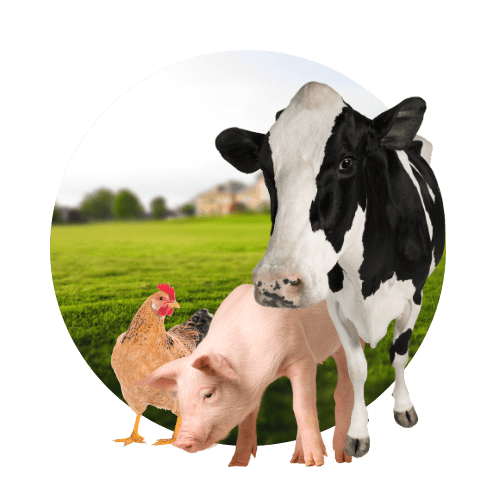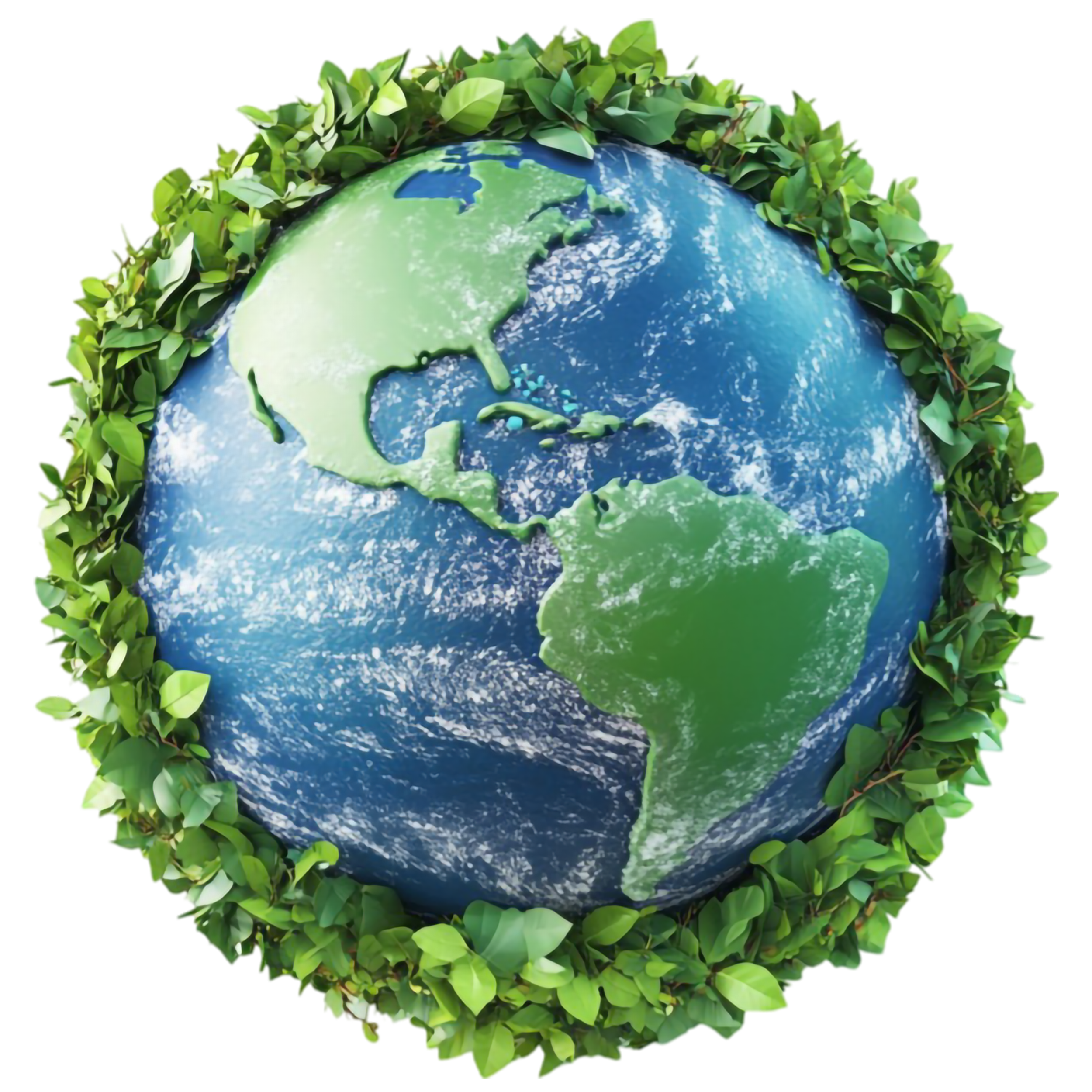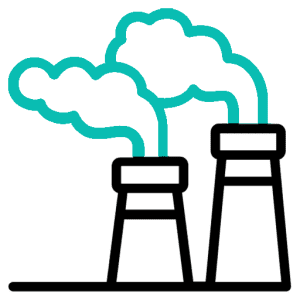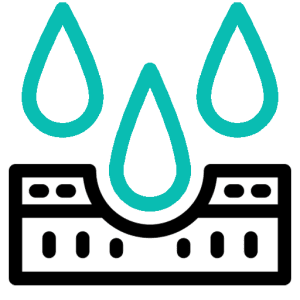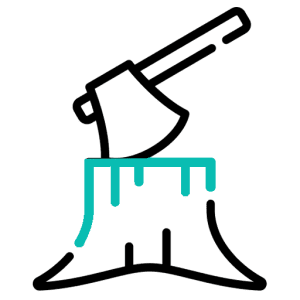Nos últimos anos, o tópico do consumo de laticínios tornou -se cada vez mais controverso e fortemente debatido. Embora o leite tenha sido apontado há muito tempo como um item básico de uma dieta saudável, houve uma preocupação crescente sobre os riscos potenciais à saúde e o impacto ambiental de sua produção. Com o surgimento de alternativas de leite à base de plantas e a crescente popularidade do veganismo, muitos estão questionando a necessidade e a ética de consumir produtos lácteos. Neste artigo, nos aprofundaremos no dilema de laticínios, descobrindo os riscos potenciais à saúde associados ao consumo de leite e lançando luz sobre o impacto ambiental da produção de laticínios. Também exploraremos as razões por trás do surgimento de opções alternativas de leite e examinaremos as evidências que sustentam os dois lados do debate de laticínios. Ao se aprofundar nessa questão complexa e muitas vezes polarizadora, esperamos fornecer uma análise abrangente e objetiva da indústria de laticínios e seus efeitos na saúde humana e no meio ambiente.

Risco aumentado de doenças crônicas
O consumo de quantidades excessivas de produtos lácteos tem sido associado a um risco aumentado de desenvolver doenças crônicas. Os estudos de pesquisa encontraram associações entre alta ingestão de laticínios e condições como doenças cardiovasculares, diabetes tipo 2 e certos tipos de câncer. Uma explicação potencial para essa associação é o alto teor de gordura saturada presente em muitos produtos lácteos, o que pode contribuir para níveis elevados de colesterol e subsequente doenças cardíacas. Além disso, os produtos lácteos podem conter hormônios, como estrogênio e fator de crescimento do tipo insulina (IGF-1), que foram implicados no desenvolvimento de certos cânceres. Esses achados enfatizam a necessidade de os indivíduos estarem atentos ao consumo de laticínios e considerar fontes alternativas de nutrientes para reduzir o risco de doenças crônicas.
Água insustentável e uso da terra
A produção de produtos lácteos também levanta preocupações sobre água insustentável e uso da terra. A produção de leite requer grandes quantidades de água para irrigação, hidratação de gado e processos de limpeza. Isso coloca um ônus significativo às fontes de água locais, especialmente em regiões com escassez de água. Além disso, a agricultura de laticínios exige grandes extensões de terra para pastagem e cultivo de alimentos para animais. A expansão das operações de laticínios geralmente leva ao desmatamento e à conversão de habitats naturais em terras agrícolas, resultando na perda de biodiversidade e interrupção dos ecossistemas. O uso intensivo dos recursos da água e da terra na produção de leite destaca a necessidade urgente de práticas sustentáveis e abordagens alternativas para atender às demandas nutricionais de uma população em crescimento sem danificar ainda mais o meio ambiente.
Preocupações e abusos de bem -estar animal
As preocupações e abusos do bem -estar animal são predominantes na indústria de laticínios, apresentando desafios éticos que não podem ser ignorados. Ao longo do processo de produção de leite, os animais em fazendas de laticínios são frequentemente submetidos a condições de vida superlotadas e insalubres, levando ao estresse e aumento do risco de transmissão de doenças. A prática comum de separar os bezerros recém -nascidos de suas mães logo após o nascimento causa sofrimento emocional para a mãe e a panturrilha. Além disso, as vacas são frequentemente submetidas a procedimentos dolorosos, como desmaios e encaixe na cauda, sem anestesia adequada ou alívio da dor. Essas práticas não apenas comprometem o bem-estar dos animais, mas também levantam questões sobre a ética da indústria de laticínios como um todo. É crucial abordar essas preocupações de bem -estar animal e trabalhar para implementar práticas mais humanas na produção de leite.
Uso excessivo de antibióticos
O uso excessivo de antibióticos na indústria de laticínios apresenta preocupações significativas para a saúde humana e o meio ambiente. Os antibióticos são comumente administrados a vacas leiteiras para prevenir e tratar infecções bacterianas. No entanto, seu uso excessivo contribuiu para o desenvolvimento de bactérias resistentes a antibióticos, tornando esses medicamentos vitais menos eficazes no combate a infecções em animais e humanos. Além disso, os antibióticos administrados a vacas leiteiras podem contaminar as fontes do solo e da água circundantes através do escoamento do estrume, levando ao potencial de poluição ambiental. O uso generalizado de antibióticos na produção de leite requer monitoramento e regulamentação cuidadosos para garantir a preservação da saúde humana e a proteção do meio ambiente.
Emissões de metano e mudança climática
As emissões de metano representam um desafio significativo para mitigar as mudanças climáticas. O metano, um potente gás de efeito estufa, é liberado na atmosfera através de várias fontes, incluindo processos naturais, extração e uso de combustíveis fósseis e atividades agrícolas. Em particular, a indústria de laticínios contribui para as emissões de metano através da fermentação entérica, um processo digestivo em vacas que produz metano como subproduto. A liberação de metano na atmosfera contribui para o aquecimento global e exacerba os impactos das mudanças climáticas. Para abordar efetivamente essa questão, medidas como nutrição animal melhorada, tecnologias de captura de metano e práticas agrícolas sustentáveis precisam ser implementadas para reduzir as emissões de metano da indústria de laticínios e mitigar seu impacto em nossas mudanças no clima.
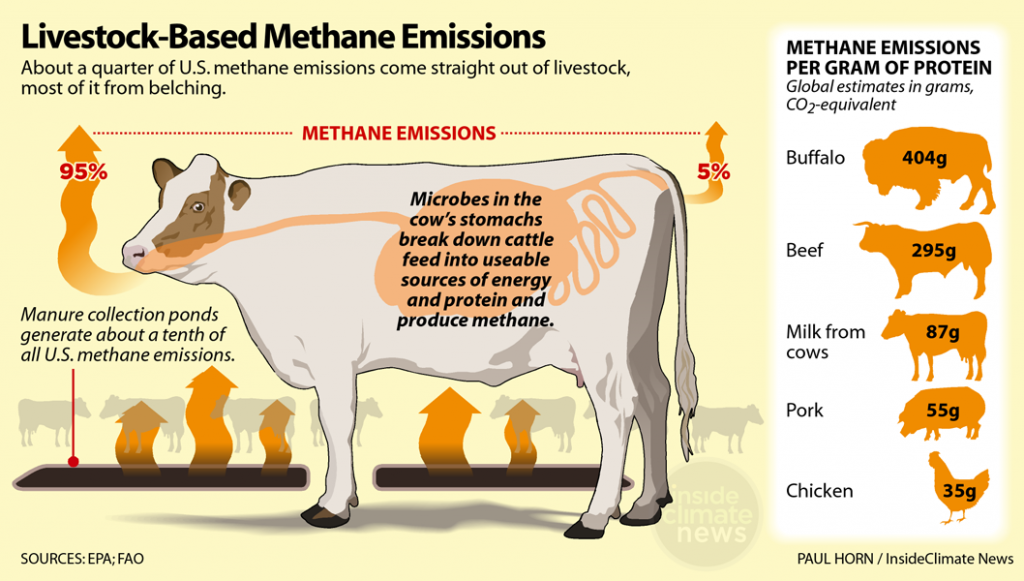
Pesticidas e fertilizantes nocivos
O uso de pesticidas e fertilizantes nocivos na agricultura representa preocupações significativas para a saúde humana e o meio ambiente. Esses produtos químicos são comumente usados para controlar pragas, doenças e promover o crescimento das culturas, mas sua aplicação generalizada levantou questões alarmantes sobre seu impacto a longo prazo. Os pesticidas podem contaminar o solo, fontes de água e suprimentos de alimentos, posando riscos para a vida selvagem, ecossistemas e consumidores humanos. Além disso, a exposição a esses produtos químicos tem sido associada a vários problemas de saúde, incluindo câncer, problemas reprodutivos e distúrbios neurológicos. À medida que nos aprofundamos na indústria de laticínios e seus desafios associados, é imperativo abordar o uso de pesticidas e fertilizantes nocivos para garantir um futuro sustentável e saudável para nossos corpos e meio ambiente.
Poluição e contaminação ambiental
A indústria de laticínios não é imune à questão da poluição e contaminação ambiental. A produção e processamento de leite envolvem várias atividades que podem liberar poluentes no ar, água e solo. Um contribuinte significativo para a poluição ambiental é o gerenciamento inadequado de resíduos de animais. Grandes operações de laticínios geram quantidades substanciais de esterco, que, se não forem manuseadas e armazenadas adequadamente, podem ser lançadas em fontes de água próximas, contaminando -as com nitrogênio, fósforo e patógenos. Essa contaminação pode ter efeitos prejudiciais nos ecossistemas aquáticos e representar riscos para a saúde humana quando essas fontes de água poluídas são usadas para beber ou irrigação. Além disso, o uso intensivo de energia e as emissões de gases de efeito estufa associadas à agricultura leiteira contribuem para as mudanças climáticas, exacerbando ainda mais os desafios ambientais. É crucial para a indústria de laticínios adotar práticas sustentáveis e implementar medidas para mitigar a poluição e a contaminação, garantindo um ambiente mais limpo e saudável para as gerações futuras.
Falta de supervisão regulatória e transparência
No contexto da indústria de laticínios, surgem preocupações com a falta de supervisão regulatória e transparência. A natureza complexa da produção de leite, da fazenda às instalações de processamento, requer regulamentos robustos para garantir a segurança e a qualidade dos produtos lácteos. No entanto, a estrutura regulatória atual fica aquém do abordando adequadamente esses problemas. Há uma necessidade de monitoramento mais rigoroso e aplicação de padrões, bem como relatórios e divulgação transparentes de informações sobre práticas de produção, bem -estar animal e impactos ambientais. Sem supervisão e transparência eficazes, os consumidores não têm conhecimento de riscos potenciais à saúde associados à produção de leite, e fica difícil responsabilizar o setor por sua pegada ambiental. Abordar essas deficiências é crucial para garantir a integridade e a sustentabilidade do setor de laticínios para os consumidores e o meio ambiente.
Em conclusão, fica claro que a indústria de laticínios tem riscos significativos à saúde e impactos ambientais que não podem ser ignorados. Desde os altos níveis de gordura saturada e hormônios no leite, até o uso excessivo de água e terra necessário para a produção, é hora de considerar seriamente as consequências do consumo de laticínios. Como consumidores, temos o poder de fazer escolhas informadas e conscientes em apoio à nossa saúde e ao meio ambiente. Vamos continuar a nos educar e tomar decisões responsáveis que se beneficiam de nós mesmos e ao nosso planeta.
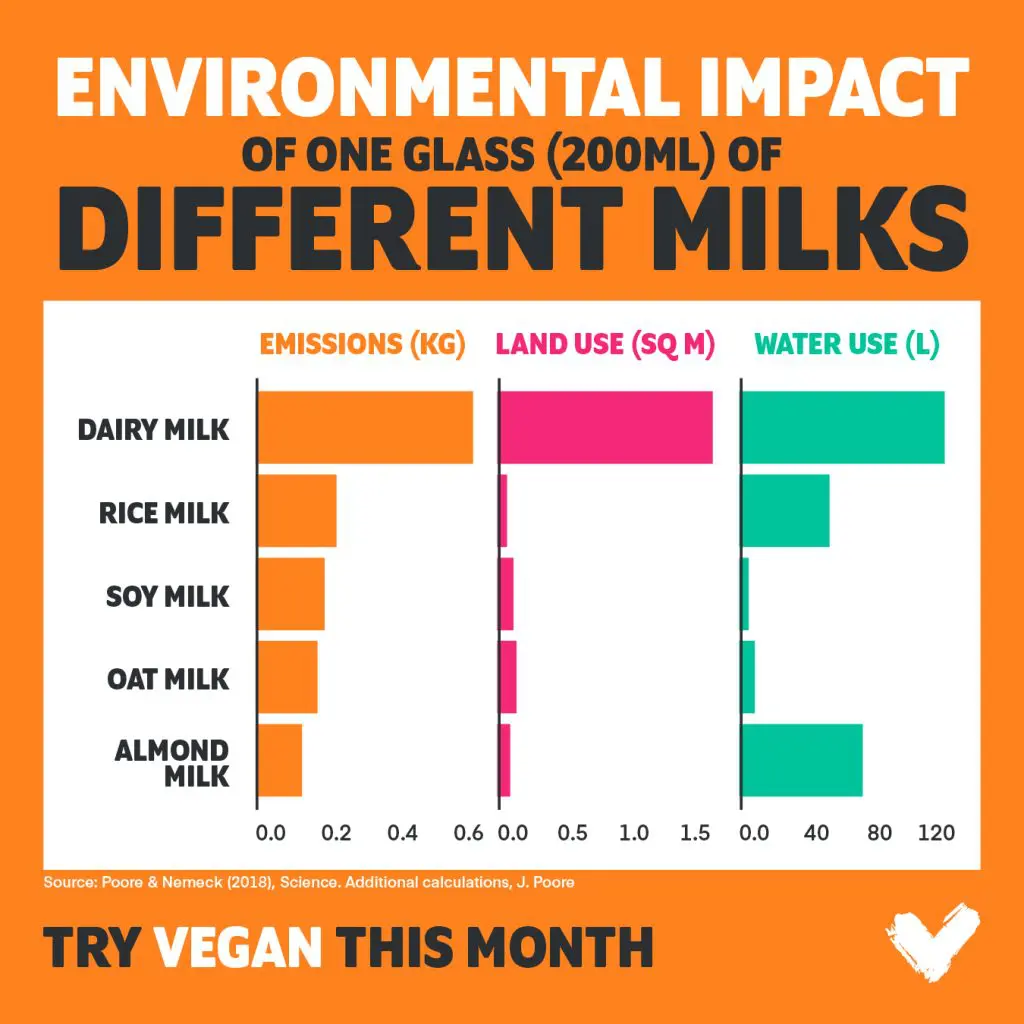
Perguntas frequentes
Quais são alguns dos riscos à saúde associados ao consumo de produtos lácteos, principalmente leite e como eles podem impactar nosso bem-estar geral?
Consumir produtos lácteos, como leite, pode levar a riscos à saúde, como intolerância à lactose, problemas digestivos, acne e vínculos em potencial para certos tipos de câncer. O consumo excessivo também pode contribuir para o ganho de peso e os altos níveis de colesterol, aumentando o risco de doenças cardíacas. Algumas pessoas podem experimentar alergias ou sensibilidades a produtos lácteos, impactando ainda mais seu bem-estar geral. É importante estar atento a esses riscos e considerar fontes alternativas de nutrientes para manter uma dieta equilibrada e saudável.
Como a produção de leite contribui para questões ambientais, como desmatamento, poluição da água e emissões de gases de efeito estufa?
A produção de leite contribui para questões ambientais por meio do desmatamento, limpando as terras para pastagens de gado e alimentos, poluição da água do escoamento de esterco e entradas químicas e emissões de gases de efeito estufa de metano produzido por vacas e dióxido de carbono liberados durante a produção e transporte de alimentos. As intensivas práticas agrícolas necessárias para a produção de leite também contribuem para a degradação do solo e a perda de biodiversidade. No geral, a indústria de laticínios tem um impacto significativo nos esforços ambientais e de sustentabilidade, para mitigar esses efeitos.
Existem alternativas sustentáveis aos produtos lácteos tradicionais que podem ajudar a mitigar os impactos negativos à saúde e ambiental da produção de leite?
Sim, existem várias alternativas sustentáveis aos laticínios tradicionais, incluindo leites à base de plantas, como amêndoa, soja, aveia e leite de coco. Essas alternativas têm pegadas ambientais mais baixas, requerem menos água e terra e emitem menos gases de efeito estufa em comparação com a produção de laticínios. Eles também oferecem uma série de benefícios à saúde, como serem livres de colesterol, livres de lactose e frequentemente fortificados com nutrientes essenciais como cálcio e vitamina D. Além disso, os avanços na tecnologia levaram ao desenvolvimento de produtos lácteos alternativos feitos de fontes como nozes, sementes e leguminosas, fornecendo aos consumidores uma variedade de opções sustentáveis a mitigação, os negativos, e os leguminosas.
Quais são algumas soluções ou iniciativas em potencial que podem ajudar a reduzir os efeitos negativos da produção de laticínios na saúde humana e no meio ambiente?
A transição para alternativas baseadas em vegetais, promovendo práticas agrícolas sustentáveis, implementando regulamentos mais rigorosos sobre emissões da indústria de laticínios, apoiando fazendas de laticínios locais em pequena escala e educando os consumidores sobre os impactos do consumo de laticínios na saúde e no meio ambiente são algumas soluções em potencial para reduzir os efeitos negativos da produção de laticínios. Além disso, investir em pesquisa e tecnologia para melhorar a eficiência na agricultura leiteira e explorar fontes alternativas de proteínas também pode ajudar a mitigar esses impactos.
No geral, é necessária uma combinação de mudanças políticas, conscientização do consumidor e inovação do setor para enfrentar os desafios colocados pela produção de laticínios na saúde humana e no meio ambiente.
Como os consumidores podem fazer escolhas mais informadas sobre seu consumo de laticínios para promover a saúde pessoal e a sustentabilidade ambiental?
Os consumidores podem fazer escolhas mais informadas sobre o consumo de laticínios, optando por produtos lácteos orgânicos ou de origem sustentável, escolhendo alternativas baseadas em plantas, verificando os rótulos para certificações como o bem-estar animal aprovado ou o USDA Organic, apoiando as fazendas de laticínios locais, reduzindo o consumo geral de laticínios e educando-se sobre o impacto ambiental da produção de DAI. Ao priorizar a saúde e a sustentabilidade, os consumidores podem desempenhar um papel vital na promoção de uma indústria de laticínios mais ética e ambientalmente amigável.



